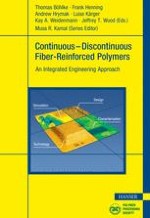2019 | Buch
Continuous–Discontinuous Fiber-Reinforced Polymers
An Integrated Engineering Approach
herausgegeben von: Thomas Böhlke, Frank Henning, Andrew Hrymak, Luise Kärger, Kay A. Weidenmann, Jeffrey T. Wood
Verlag: Carl Hanser Verlag GmbH & Co. KG
